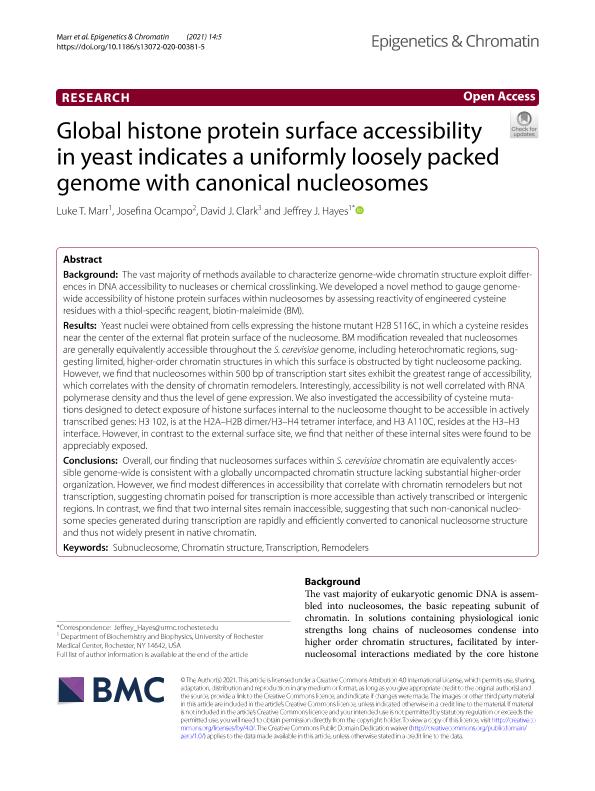Mostrar el registro sencillo del ítem
dc.contributor.author
Marr, Luke T.
dc.contributor.author
Ocampo, Josefina

dc.contributor.author
Clark, David J.
dc.contributor.author
Hayes, Jeffrey J.
dc.date.available
2021-08-17T17:17:26Z
dc.date.issued
2021-12-11
dc.identifier.citation
Marr, Luke T.; Ocampo, Josefina; Clark, David J.; Hayes, Jeffrey J.; Global histone protein surface accessibility in yeast indicates a uniformly loosely packed genome with canonical nucleosomes; BioMed Central; Epigenetics and Chromatin; 14; 1; 11-12-2021; 1-17
dc.identifier.issn
1756-8935
dc.identifier.uri
http://hdl.handle.net/11336/138355
dc.description.abstract
Background: The vast majority of methods available to characterize genome-wide chromatin structure exploit differences in DNA accessibility to nucleases or chemical crosslinking. We developed a novel method to gauge genome-wide accessibility of histone protein surfaces within nucleosomes by assessing reactivity of engineered cysteine residues with a thiol-specific reagent, biotin-maleimide (BM). Results: Yeast nuclei were obtained from cells expressing the histone mutant H2B S116C, in which a cysteine resides near the center of the external flat protein surface of the nucleosome. BM modification revealed that nucleosomes are generally equivalently accessible throughout the S. cerevisiae genome, including heterochromatic regions, suggesting limited, higher-order chromatin structures in which this surface is obstructed by tight nucleosome packing. However, we find that nucleosomes within 500 bp of transcription start sites exhibit the greatest range of accessibility, which correlates with the density of chromatin remodelers. Interestingly, accessibility is not well correlated with RNA polymerase density and thus the level of gene expression. We also investigated the accessibility of cysteine mutations designed to detect exposure of histone surfaces internal to the nucleosome thought to be accessible in actively transcribed genes: H3 102, is at the H2A–H2B dimer/H3–H4 tetramer interface, and H3 A110C, resides at the H3–H3 interface. However, in contrast to the external surface site, we find that neither of these internal sites were found to be appreciably exposed. Conclusions: Overall, our finding that nucleosomes surfaces within S. cerevisiae chromatin are equivalently accessible genome-wide is consistent with a globally uncompacted chromatin structure lacking substantial higher-order organization. However, we find modest differences in accessibility that correlate with chromatin remodelers but not transcription, suggesting chromatin poised for transcription is more accessible than actively transcribed or intergenic regions. In contrast, we find that two internal sites remain inaccessible, suggesting that such non-canonical nucleosome species generated during transcription are rapidly and efficiently converted to canonical nucleosome structure and thus not widely present in native chromatin.
dc.format
application/pdf
dc.language.iso
eng
dc.publisher
BioMed Central

dc.rights
info:eu-repo/semantics/openAccess
dc.rights.uri
https://creativecommons.org/licenses/by/2.5/ar/
dc.subject
CHROMATIN STRUCTURE
dc.subject
REMODELERS
dc.subject
SUBNUCLEOSOME
dc.subject
TRANSCRIPTION
dc.subject.classification
Otros Tópicos Biológicos

dc.subject.classification
Ciencias Biológicas

dc.subject.classification
CIENCIAS NATURALES Y EXACTAS

dc.title
Global histone protein surface accessibility in yeast indicates a uniformly loosely packed genome with canonical nucleosomes
dc.type
info:eu-repo/semantics/article
dc.type
info:ar-repo/semantics/artículo
dc.type
info:eu-repo/semantics/publishedVersion
dc.date.updated
2021-07-30T19:22:14Z
dc.journal.volume
14
dc.journal.number
1
dc.journal.pagination
1-17
dc.journal.pais
Reino Unido

dc.journal.ciudad
Londres
dc.description.fil
Fil: Marr, Luke T.. University of Rochester Medical Center; Estados Unidos
dc.description.fil
Fil: Ocampo, Josefina. Consejo Nacional de Investigaciones Científicas y Técnicas. Instituto de Investigaciones en Ingeniería Genética y Biología Molecular "Dr. Héctor N. Torres"; Argentina
dc.description.fil
Fil: Clark, David J.. National Instituto of Child Health & Human Development; Estados Unidos
dc.description.fil
Fil: Hayes, Jeffrey J.. University of Rochester Medical Center; Estados Unidos
dc.journal.title
Epigenetics and Chromatin
dc.relation.alternativeid
info:eu-repo/semantics/altIdentifier/doi/http://dx.doi.org/10.1186/s13072-020-00381-5
dc.relation.alternativeid
info:eu-repo/semantics/altIdentifier/url/https://epigeneticsandchromatin.biomedcentral.com/articles/10.1186/s13072-020-00381-5
Archivos asociados
